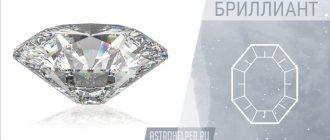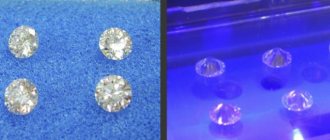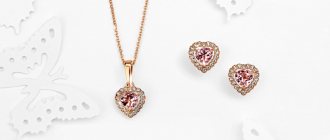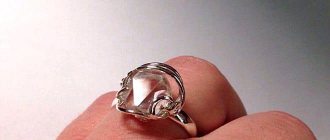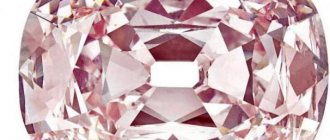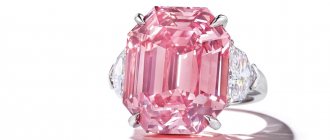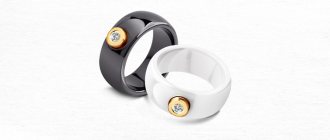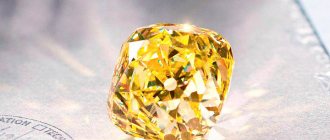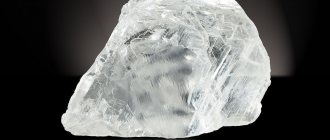Once again we are pleased to welcome our dear readers, both new and regular! Classic colorless diamonds have a rich and extensive history of surprise finds, thefts, disappearances and reappearances at both auctions and the black market. But time passes, everything moves forward, new diamonds of different colors are found, which are called fancy. One of their direct representatives is the cognac diamond, which, due to its rarity and uniqueness, is quickly gaining popularity.
This is exactly what we will talk about today. We will learn not only the history of its appearance, but why it became so famous and why a ring with a cognac diamond and other jewelry made from it are so expensive and delightful.
We are confident that the material we have selected will arouse your genuine interest and attract your attention! We wish you a pleasant and exciting reading!
How brown shades are made
In nature, Cognac color forms in the same way as other diamond colors. Under the influence of extreme temperatures and pressure over millions of years, the crystal lattice of the stone is deformed, and other chemical elements are built into it.
In the case of cognac specimens, these are iron, nitrogen and nickel. Saturation depends on the composition and quantity of each of them. Nitrogen should also be crystalline. If it remains gaseous, the diamond will be colorless.
How is Cognac color formed?
The color “cognac”, or “cognac”, can be produced artificially (as we discussed above) and can be found in the natural environment.
In nature, such a diamond palette is formed under the influence of strong pressure in tandem with high temperatures.
In this case, the crystal lattice of the mineral is distorted and also deformed. Subsequently, it is enriched with new impurities, such as iron, nickel, and nitrogen. Thanks to this effect and enrichment with impurities, the mineral acquires a brown palette of varying degrees of severity. The degree of severity depends on the intensity of exposure to pressure and high temperatures and on the amount of impurities.
History of Cognac Diamonds
The “biography” of the stone is reminiscent of the fairy tale about the ugly duckling who became a beautiful swan:
- Brown, opaque diamonds have been considered technical diamonds since their discovery in Australia half a century ago. And they were used accordingly - for the needs of science, technology, and high-precision industries.
- The stone's finest hour was the first year of the new millennium. In 2001, Belgian jeweler Pascal Bruni brought a collection of jewelry with brown diamonds to Basel, Switzerland. It was accompanied by advertisements hinting at the depletion of Australian mines. Plus a romantic brand (the stone was already called “cognac”). Visitors to the prestigious exhibition appreciated the jewelry: everything was sold out.
- Cognac shades were loved by bohemians and the cream of society.
Pascal Bruni did with brown diamonds what Fawaz Gruosi did with black diamonds in the mid-1990s. The outsiders became crowd favorites.
Since then, the brown pebbles have ceased to discolor to white, as they did before.
Cognac diamond
The rise from industrial material to work of art
The same cognac diamond ring and other items made from cognac diamonds did not immediately begin to delight with their amber hue.
Much earlier, until the 20th century, they were used only in industry (even large pieces) and it was believed that they did not represent any material value.
Only at the very beginning of the previous century of jewelry making, the master and part-time artist, at an exhibition in Basel, presented the first jewelry, which was a brown diamond and its gold design. The jeweler's name was Bruni Pasquale. It was then that the name of this mineral was born: a “cognac”-colored diamond.
It should be noted that the setting and inherent decorations on which the diamond is designed are made only from yellow gold, as it emphasizes the natural brown hue and gives it even more variegation.
Other options for accompanying materials are not welcome, as they only spoil the appearance and make this type of diamond dull.
It is this miracle that is different from the rest, the ascent into the jewelry world that is in high demand and popularity.
Classification of brown diamonds
Cognac-colored processed diamonds are divided into two categories:
- Elite. Includes fancy, richly colored specimens without nitrogen crystals in the structure. But they are also the cheapest of the fantasy ones (the most expensive are red ones).
- Cape. This includes yellow-brown diamonds, also called Cognac Diamond. They have nitrogen crystals in their structure, which reduce their density and transparency, that is, properties that affect quality.
Cognac diamonds have seven main shades, of which the most popular are:
- Champagne. The lightest, almost yellow, almost always with an additional tint.
- Brown. The most common.
- Chocolate. The rarest.
- Cognac. Gave the name to the whole group.
The official gradation of shades is from “very light champagne” to “dark cognac”.
At the everyday level, there is its own “cognac” scale: honey, hazelnut, golden, bronze, cinnamon, walnut, coffee. It helps to navigate in color.
Features and origin of the stone
Now these diamonds are the only colored diamonds of their kind that are cheaper than white ones. However, in the near future, everything will change. The Argyle diamond mine in Australia is scheduled to close. This treasure trove contained the most deposits of brown treasure. Unfortunately, all supplies have already been exhausted.
When the owner of the mine closes it, it is unlikely that anyone will be able to continue this business. The extraction of deposits will stop, and the goods on the market will become tens of times smaller. The so-called bonanza will disappear.
Today, a 1-carat brown diamond costs between 4 and 10 thousand dollars. And when there is a shortage of a product, its price increases sharply. Over time, cognac jewelry will cost up to 80 thousand dollars. Impressive, right?
Most of this gemstone is mined in Australia (about half of all production). Two more locations of valuables were discovered in South Africa and Brazil.
It takes millions of years for this decoration to form. Being deep underground, they are subject to very high temperatures and constant strong pressure. This contributes to the formation of deformation and distortion in the crystal lattice of the stone, as well as the appearance of new microelements. They are the ones that attract all shades of green and, as a result, reflect a variety of colors in the diamond. The formation of a brown tint is also influenced by the presence of a mixture of iron, nitrogen and nickel in the jewelry.
Previously, brown stones were used mainly in industry. Much less often - for the manufacture of jewelry.
Only at the beginning of the twentieth century, Pasquale Bruni (jeweler and designer) unveiled brown diamond jewelry at the Basel Exhibition, making it known to the general public. A special name “cognac diamond” was invented for this jewelry and a separate category called “cape” was identified.
The frame for such jewelry is made only of yellow gold, in order to emphasize the natural, natural brown color. White gold as a setting is not even welcome, as it spoils the appearance of the finished product, making it faded and dull.
Shades
Cognac diamond has several shades. Jewelers count about seven of them. It all depends on the color saturation and impurities that are included in its composition. The gradation of shades goes from the lightest and most delicate to the eye to the brightest dark colors. The tone is determined according to the international classification of GIA (gemological laboratory).
All colors were divided into groups, and each of the colors received its own special name. For example, the name Chocolate means that the diamond has a rich dark brown hue, similar to chocolate. The name Champagne indicates that the product is similar in color to champagne, that is, a light brown shade. And such a concept as a cognac diamond makes it clear that the jewelry has a very light, slightly noticeable brownish tint.
There are several other names by which it is easy to determine the tone of the stone:
- honey;
- coffee;
- Walnut;
- gold;
- hazelnut;
- cinnamon;
- bronze.
As a result, the diamond takes on a wide variety of shapes. In the movie Titanic, a piece of jewelry was shown that was shaped like a heart by an engraver. In the same way, diamonds are remade into different models using shapes such as oval, pear, cushion, marquise, princess, etc.
Interesting to know
Jewelers classify all of the above tones and colors of diamond as fancy. There is no specific evaluation system or price lists. How then is the cost of a product determined? The pace is set by auction prices, especially at Christie's and Sotheby's.
Today, people can pay about 4 thousand dollars for 1 carat. And this is not the limit. Brown jewels are considered the cheapest of all fancy diamonds. But that's it for now. The consumer market will soon feel an acute shortage of this stone and will be ready to pay for it tens of times higher than the current price.
Residents of Europe and America are beginning to appreciate this product and do not skimp on spending a lot of money on it. Cognac shades, tones of champagne and chocolate are extremely popular.
Jewelry value
Unlike white diamonds, for colored diamonds the main characteristic that determines the value of the stone is color. It outweighs even mass or purity.
Taking these features into account, a separate rating scale has been developed for colored pebbles, including cognac ones, with the following parameters:
- Hue. Main visible color; brown is welcome.
- Tone. Indicates the gradation of darkness of a hue.
- Saturation. The degree of color intensity. The higher, the more expensive the stone.
Gold ring with cognac diamond
The cost of the stone will skyrocket if the main color – brown – is complemented by orange shades.
Jewelry assortment
The most affordable for Russian jewelers are brown diamonds from Yakutia. Almost all jewelry contains just such inserts:
- Brown diamonds look best in yellow or rose gold. A white setting (gold or platinum) makes the stone appear paler.
- Gold jewelry with Cognac Diamond is a luxury that suits people of all ages and skin tones. This provides a range of colors from light champagne to dark chocolate.
- Studs or a modest ring with a cognac diamond are appropriate in the office. Luxurious earrings with brown diamonds plus the same ring will suit an elite evening wardrobe. Cufflinks, a tie clip, a ring with a dark stone are noble men's accessories.
Jewelry with cognac diamonds
If you plan to wear several pieces of jewelry at the same time (this is not bad manners for cognac diamonds), you need to choose stones of the same tone.
Prices for Russian gold jewelry with natural cognac diamonds are tens of thousands of rubles.
How to spot a fake
Often, instead of natural stone, artificial analogs are offered - cubic zirconia and moissanite. Or real, but refined stones. As a result of processing, the shade of the stone improves, but the degree of naturalness decreases. Sellers do not always advertise this.
Therefore, having outlined a decoration with stones in shades from champagne to chocolate, you need to determine the quality of the future purchase:
- The label and quality certificate are examined.
- The stone is evaluated under a 10x magnifying glass. A natural rough cape diamond has microcracks or voids; the color is uniform, homogeneous. If it has been refined, the color inclusions that fill the voids will be visible.
- The stone is sent for professional examination. A jeweler will be able to distinguish a fake by using special testing devices. Characteristics that cannot be changed will be checked: reflectivity, electrical conductivity, edges. In a special solution, the diamond will sink, and the fakes will float.
Laboratories (for example, GIA) issue a separate form with an expert opinion for colored diamonds. The gemological expert opinion reflects two aspects: the origin of the stone and the color.
Cognac diamond ring
A reliable marker is price. For example, an Indian moissanite stone, positioned as a “rare, cognac-colored diamond” of 1.62 carats (cognac color, light Fancy Brown) is offered at a price of 5 thousand rubles.
Cognac diamonds as an investment
A controversial issue for today. The opinions of experts are opposite:
- Now is the best time to buy Cognac Diamond stones or jewelry with them. The average price of a carat ($4,000) is justified and even underestimated. The main source of stone, Australia's Argyle mine, is almost exhausted. Brazil and South Africa have microscopic reserves. Therefore, a shortage is not far off, which will increase the price by an order of magnitude or more, up to 80,000.
- The price is unreasonably high. She was influenced by fashion and artificially inflated hype. If you buy it, it should be a separate stone, and not jewelry with it.
A ring, pendant or earrings with stones are worth buying if you simply like them and are pleasant to wear.
Earrings with cognac diamonds
Table with approximate prices for cognac diamonds.
| Weight | Good quality | Medium quality |
| 0.01 carat | 3 | 3 |
| 0.05 carat | 13 | 10 |
| 0.10 carat | 35 | 25 |
| 0.15 carat | 70 | 50 |
| 0.20 carat | 95 | 70 |
| 0.25 carat | 175 | 120 |
| 0.30 carat | 405 | 280 |
| 0.40 carat | 625 | 440 |
| 0.49 carat | 720 | 120 |
| 0.50 carat | 2300 | 1600 |
| 0.75 carat | 3430 | 2400 |
| 0.90 carat | 6930 | 4850 |
| 1.00 carat | 12060 | 8440 |
| 1.50 carat | 24000 | 16800 |
| 2.00 carat | 56000 | 39200 |
| 3.00 carat | 105000 | 73000 |
| 4.00 carat | 173500 | 121400 |
| 5.00 carat | 182000 | 127000 |
Famous specimens
Cognac-colored diamonds are inferior to others in terms of characteristics. But there are outstanding examples:
- The largest cognac diamond (champagne color) was found at the end of the 19th century. The diamond adorned the breast ornament of the Maharaja, the ruler of Patiala. The necklace disappeared in the turbulent year of 1947, when India gained independence from the British Crown.
- The most famous cognac diamond is the Golden Jubilee. The weight of the source diamond is 746.5 carats, the diamond weighs 545.67 carats. Found in 1985, presented to the King of Thailand for his 50th birthday, after which he was named. Costs almost $12 million.
- "Victoria-Transvaal" (68 carats).
- "Kimberly" (70 carats).
- "Eastern Star" (111 carats).
All sourced in South Africa. The last three gained popularity, becoming “movie characters” and auction lots at Christie’s and Sotheby’s.
Brooch with brown stone
Investing in Brown Diamonds
Jewelry is a popular investment destination, and fancy diamonds are one of the most profitable sectors. Research is regularly conducted to determine the prospects of investing in colored diamonds and other jewelry rarities. Based on the results of the latest market analysis, experts assured that cognac diamonds will soon become the most sought-after fancy diamond. Over the first decade of this century, yellow and brown diamonds have already increased in price by 180%, the results of the next decade exceeded 200%.
Auction trading analysts noted that prices for fancy diamonds are now higher than in the past. The most valuable are rare specimens - these include brown ones. The most suitable diamonds for investment are champagne, cognac, chocolate, and walnut-colored diamonds.
